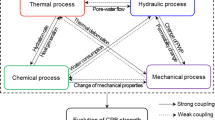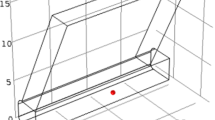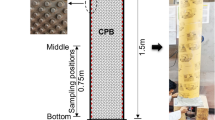Abstract
Tailings backfill, which is a subsurface fill mass, has been extensively utilized worldwide in underground mines to fill mined-out cavities for the purposes of ground control and tailings disposal. Just after placement, very early-age backfill which commonly contains a large volume of water exhibits little or no interparticle bonding, and is subjected to the risk of liquefaction induced by routine mine blasting. In this study, a modified total-stress viscoplastic cap model is developed to investigate the blast-induced liquefaction susceptibility of very early-age fill mass under various practical backfilling and field conditions. The developed model well represents the strain-rate and fluid-compressibility dependence of nonlinear material behavior under such dynamic conditions, and also captures the development of excess pore pressure due to irrecoverable volume changes. The model is validated against a series of blast and impact tests on saturated natural soils (sand and silt) and tailings fill masses, and a good agreement is found between the experimental and simulated results. Subsequently, the model is applied to investigate the effects of drainage conditions, distance from detonation, stope size, location of retaining structure, and blast sequence on the liquefaction susceptibility of early-age fill mass after mine blasting. The results obtained from the study will provide practical insight into the blast liquefaction potential of backfill mass in field conditions.

(Modified after Murray 2007)





























Similar content being viewed by others
References
Ahmed L, Ansell A (2014) Vibration vulnerability of shotcrete on tunnel walls during construction blasting. Tunn Undergr Sp Technol 42:105–111
Al-Qasimi EMA, Charlie WA, Woeller DJ (2005) Canadian liquefaction experiment (CANLEX): blast-induced ground motion and pore pressure experiments. Geotech Test J 28(1):1–13
Al-Tarhouni M, Simms P, Sivathayalan S (2011) Cyclic behaviour of reconstituted and desiccated-rewet thickened gold tailings in simple shear. Can Geotech J 48:1044–1060
An J, Tuan CY, Cheeseman BA, Gazonas GA (2011) Simulation of soil behavior under blast loading. Int J Geomech 11:323–334
Aráoz G, Luccioni B (2015) Modeling concrete like materials under severe dynamic pressures. Int J Impact Eng 76:139–154
Aubertin M, Ricard JF, Chapuis RP (1998) A predictive model for the water retention curve: application to tailings from hard-rock mines. Can Geotech J 35:55–69
Awad AA (1990) A numerical model for blast-induced liquefaction using displacements-pore pressure formulations. Ph.D. thesis, Colorado State University
Baladi GY, Rohani B (1979) Elastic–plastic model for saturated sand. J Geotech Eng Div 105(4):465–480
Bloom F (2006) Constitutive models for wave propagation in soils. Appl Mech Rev 59:146–175
Bolton JM, Durnford DS, Charlie WA (1994) One-dimensional shock and quasi-static liquefaction of silt and sand. J Geotech Eng 120:1874–1888
Bretz TE (1990) Soil liquefaction resulting from blast-induced spherical stress waves. Final Rep. No. WL-TR-89-100, Weapons Laboratory, Air Force Systems Command
Bussière B (2007) Colloquium 2004: hydrogeotechnical properties of hard rock tailings from metal mines and emerging geoenvironmental disposal approaches. Can Geotech J 44:1019–1052
Charlie WA, Veyera GE, Doehring DO, Abt SR (1985) Blast induced liquefaction potential and transient pore water pressure response of saturated sands. Technical report, Colorado State University, Fort Collins
Charlie WA, Bretz TE, White LAS, Doehring DO (2013) Blast-induced pore pressure and liquefaction of saturated sand. J Geotech Geoenviron Eng 139(8):1308–1319
Chen WF, Baladi GY (1985) Soil plasticity: theory and implementation. Elsevier, Amsterdam
Cooke R (2001) Design procedure for hydraulic backfill distribution systems. J S Afr Inst Min Metall 101(2):97–102
Fahey M, Helinski M, Fourie A (2009) Some aspects of the mechanics of arching in backfilled stopes. Can Geotech J 46:1322–1336
Fall M, Benzaazoua M (2005) Modeling the effect of sulphate on strength development of paste backfill and binder mixture optimization. Cem Concr Res 35:301–314
Ferdosi B, James M, Aubertin M (2015) Numerical simulations of seismic and post-seismic behavior of tailings. Can Geotech J 92:85–92
Fragaszy RJ, Voss ME (1986) Undrained compression behavior of sand. J Geotech Eng 112:334–347
Ghassemi A, Pak A, Shahir H (2010) Numerical study of the coupled hydro-mechanical effects in dynamic compaction of saturated granular soils. Comput Geotech 37:10–24
Griffiths DV (1985) The effect of pore fluid compressibility on failure loads in elasto-plastic soil. Int J Numer Anal Methods Geomech 9(3):253–259
Griffiths DV, Li CO (1989) Accurate pore pressure calculation in undrained analysis. Eng Comput 6(4):339–342
Helinski M, Fahey M, Fourie A (2010) Coupled two-dimensional finite element modelling of mine backfilling with cemented tailings. Can Geotech J 47:1187–1200
Henrych J (1979) The dynamics of explosion and its use. Elsevier, New York
Holmberg R, Persson PA (1979) Swedish approach to contour blasting. In: Proceedings of fourth conference on explosive and blasting techniques, New Orleans, USA, pp 113–27
Huang S, Xia K, Qiao L (2011) Dynamic tests of cemented paste backfill: effects of strain rate, curing time, and cement content on compressive strength. J Mat Sci 46(15):5165–5170
Ishihara K (1984) Post-earthquake failure of a tailings dam due to liquefaction of the pond deposit. In: Proceedings of the international conference on case histories in geotechnical engineering, pp 1129–1143
Ishihara K (1993) Liquefaction and flow failure during earthquakes. Geotechnique 43(3):351–415
James M, Aubertin M, Wijewickreme D, Wilson GW (2011) A laboratory investigation of the dynamic properties of tailings. Can Geotech J 48:1587–1600
Jiang J, Blair DP, Baird GR (1995) Dynamic response of an elastic and viscoelastic full-space to a spherical source. Int J Numer Anal Methods Geomech 19:181–193
Katona BMG (1985) Evaluation of viscoplastic cap model. J Geotech Eng 110:1106–1125
Klein K, Simon D (2006) Effect of specimen composition on the strength development in cemented paste backfill. Can Geotech J 324:310–324
Le Roux K (2004) In situ properties and liquefaction potential of cemented paste backfill. Ph.D. thesis, University of Toronto
Lee WY (2006) Numerical modeling of blast induced liquefaction. Ph.D. thesis, Brigham Young University
Lu G, Fall M (2016) A coupled chemo-viscoplastic cap model for simulating the behaviour of hydrating cemented tailings backfill under blast loading. Int J Numer Anal Methods Geomech 40:1123–1149
Lu G, Fall M (2017a) A multiphysics-viscoplastic cap model for simulating the blast response of cemented tailings backfill. J Rock Mech Geotech Eng 9(3):551–564
Lu G, Fall M (2017b) Modelling blast wave propagation in a subsurface geotechnical structure made of an evolutive porous material. Mech Mater 108:21–39
Murray YD (2007) Users manual for LS-DYNA concrete material model 159. Report FHWA-HRT-05-062, Federal Highway Administration, McLean
Naylor DJ (1974) Stresses in nearly incompressible materials by finite elements with application to the calculation of excess pore pressures. Int J Numer Methods Eng 8(3):443–460
Pépin N, Aubertin M, James M (2012) Seismic table investigation of the effect of inclusions on the cyclic behaviour of tailings. Can Geotech J 49:416–426
Perzyna P (1966) Fundamental problems in viscoplasticity. Adv Appl Mech 9:243–377
Puebla H, Byrne PM, Phillips R (1997) Analysis of CANLEX liquefaction embankments: prototype and centrifuge models. Can Geotech J 34:641–657
Robertson PK, Wride CE, List BR, Atukorala U, Biggar KW, Byrne PM et al (2000) The Canadian liquefaction experiment: an overview. Can Geotech J 37:499–504
Sainoki A, Mitri HS (2016) Dynamic modelling of fault slip induced by stress waves due to stope production blasts. Rock Mech Rock Eng 49:165–181
Simo JC, Wu JW, Pister KS, Taylor RL (1986) Assessment of cap model: consistency return algorithms and rate–dependent extension. J Eng Mech 114(2):191–218
Sivakugan N, Rankine RM, Rankine KJ, Rankine KS (2006) Geotechnical considerations in mine backfilling in Australia. J Cleaner Production 14(12):1168–1175
Suazo G, Fourie A, Doherty J, Hasan A (2016) Effects of confining stress, density and initial static shear stress on the cyclic shear response of fine-grained unclassified tailings. Géotechnique 66:401–412
Tong X, Tuan CY (2007) Viscoplastic cap model for soils under high strain rate loading. J Geotech Geoenviron Eng 133:206–214
van Genuchten MT (1980) A closed-form equation for predicting the hydraulic conductivity of unsaturated soils. Soil Sci Soc Am J 44(5):892–898
van Gool BS (2007) Effects of blasting on the stability of paste fill stopes at Cannington Mine. Ph.D. thesis, James Cook University
Wang Z, Lu Y, Bai C (2008) Numerical analysis of blast-induced liquefaction of soil. Comp Geotech 35:196–209
Wijewickreme D, Sanin MV, Greenaway GR (2005) Cyclic shear response of fine-grained mine tailings. Can Geotech J 42:1408–1421
Yamamuro JA, Lade PV (1993) Effects of strain rate on instability of granular soils. Geotech Test J 16(3):304–313
Yilmaz E (2009) Investigating the hydrogeotechnical and microstructural properties of cemented paste backfill using the CUAPS apparatus. Ph.D. Thesis, Université du Québec in Abitibi-Temiscamingue
Yilmaz E, Benzaazoua M, Belem T, Bussière B (2009) Effect of curing under pressure on compressive strength development of cemented paste backfill. Miner Eng 22:772–785
Author information
Authors and Affiliations
Corresponding author
Rights and permissions
About this article
Cite this article
Lu, G., Fall, M. Simulation of Blast Induced Liquefaction Susceptibility of Subsurface Fill Mass. Geotech Geol Eng 36, 1683–1706 (2018). https://doi.org/10.1007/s10706-017-0423-5
Received:
Accepted:
Published:
Issue Date:
DOI: https://doi.org/10.1007/s10706-017-0423-5




